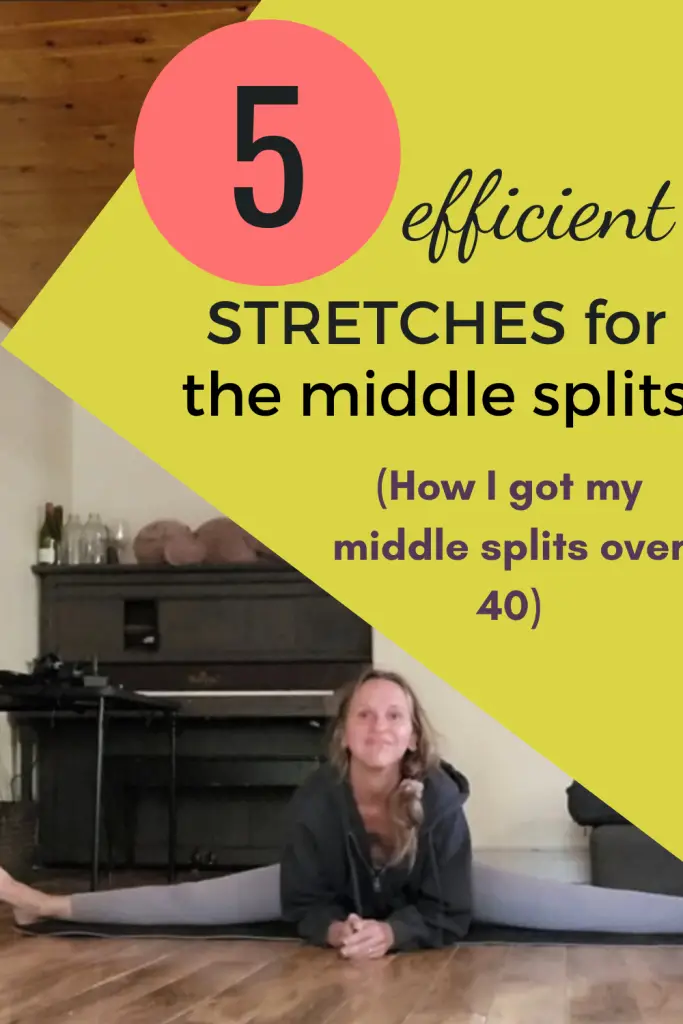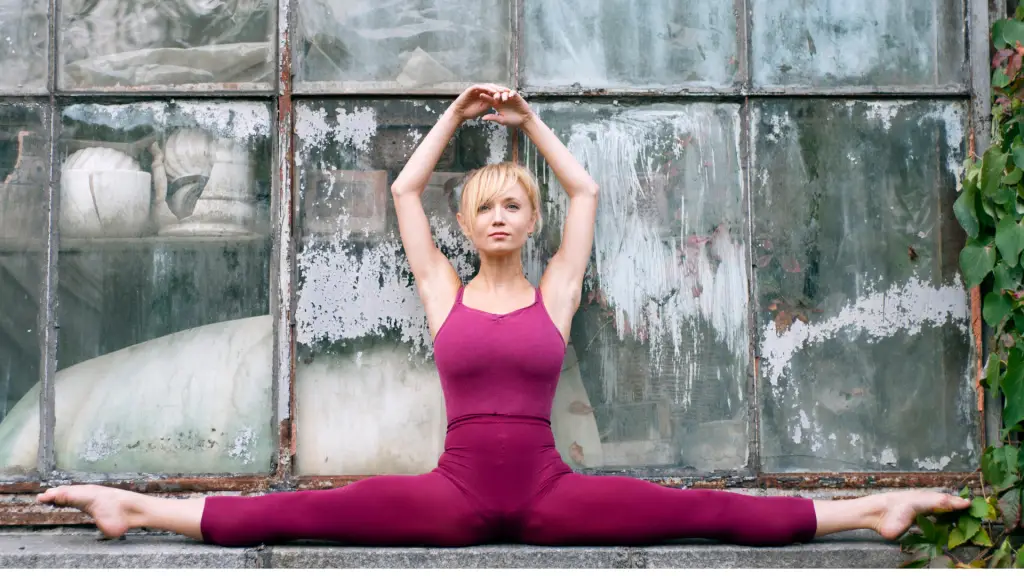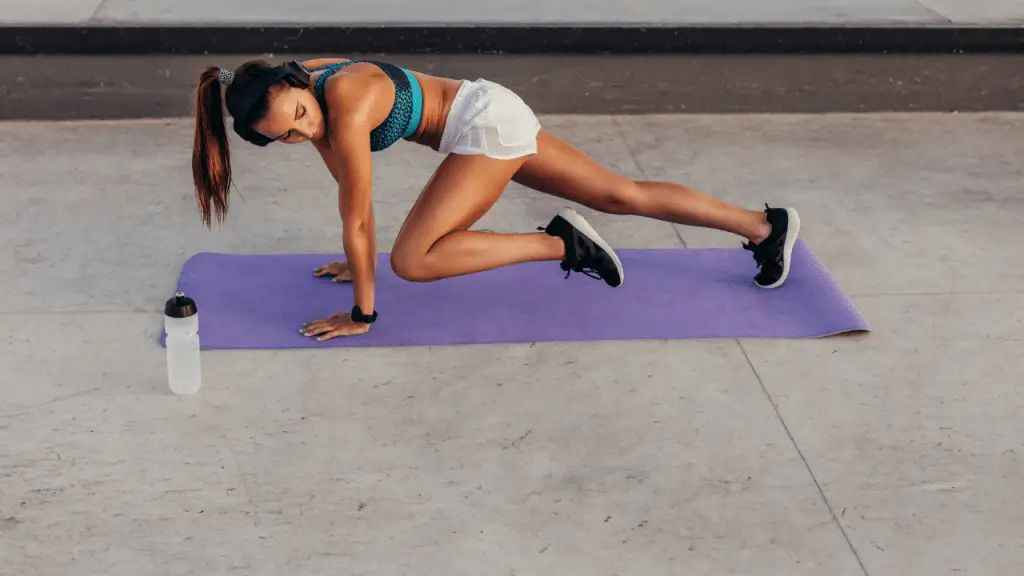It’s time for a new middle splits routine! It includes my latest favorite stretches for the middle splits. I have been experimenting a lot since I started stretching for the splits in 2021 at 43! I learned that getting the middle splits takes much longer than the front splits. It requires time and dedication, including much longer passive holds. As you advance in your practice, you can experiment with more mobility exercises and active stretches. Today’s routine is a good combination of all the above.
Stretches for Splits for Beginners
The middle splits can be challenging for beginners. I have been trying various routines for almost two years now! I started with these side split stretches for beginners here. Then, I used 6 Most Effective Side Splits Stretches (Plus Follow Along Routine) for months (I still use it) while purchasing different stretching programs and learning from my favorite yoga platform: Alo Moves.
Then, I decided I needed a bit of change and longer holds, so I created today’s routine.
UPDATE: I created a third routine, which enabled me to get my full middle splits: Inner Hip Opening Yoga to Release Your Tight Hips.
How to Do the Middle Splits for Beginners
Here are some tips I have for beginners who want to learn the middle splits:
- Warm-up: Before stretching, it helps warm up your muscles. You can do this by jogging in place or jumping jacks to increase your heart rate and blood flow. Then, perform dynamic stretches to loosen up your muscles, such as leg swings, hip circles, and lunges. I usually stretch in the evening after an active day or do a short vinyasa flow or yoga drills before stretching.
- Use props: If you struggle to reach the ground, use yoga blocks or books to support your hands as you stretch.
- Incorporate other stretches: Incorporate other stretches into your routine that target the muscles used in middle splits, such as hamstring stretches, hip flexor stretches, and inner thigh stretches. You may combine your stretches for middle splits with my Pancake Routine for better results.
- Hold the stretch: Once you have found a comfortable position, hold the stretch for at least 30 seconds, breathing deeply and relaxing into the pose.
- Be patient: Remember that achieving middle splits takes time and practice. Do not force your body into the position, which can cause injury. Instead, be patient and consistent with your stretching; you will see progress over time.
- Repeat: Consistency is key! You don’t need to stretch for half an hour a day, but I recommend stretching daily, even if it’s just 5-15 minutes.
Also, if you want to improve your overall flexibility, you will enjoy my Full-Body Flexibility Transformation.
My Full-Body Flexibility Program is the ultimate step-by-step yoga for flexibility and strength for beginners program.
Stage one focuses on building your flexibility gradually for the splits. Stage two includes backends to your training schedule, and stage three adds more advanced yoga poses for flexibility, like King Pigeon and the standing splits.

Middle Splits Vs. Front Splits
The middle splits (also known as the straddle splits), and front splits (also known as the straight leg splits) are two different types of splits that require flexibility of specific muscle groups.
The middle splits require flexibility and strength in the inner thighs, hips, and groin muscles, While the front splits require flexibility and strength in the hamstrings, hip flexors, and quadriceps muscles. Some people may find one type of split more accessible, depending on their anatomy, muscle strength, and flexibility. However, with consistent practice, improving both splits types is possible.
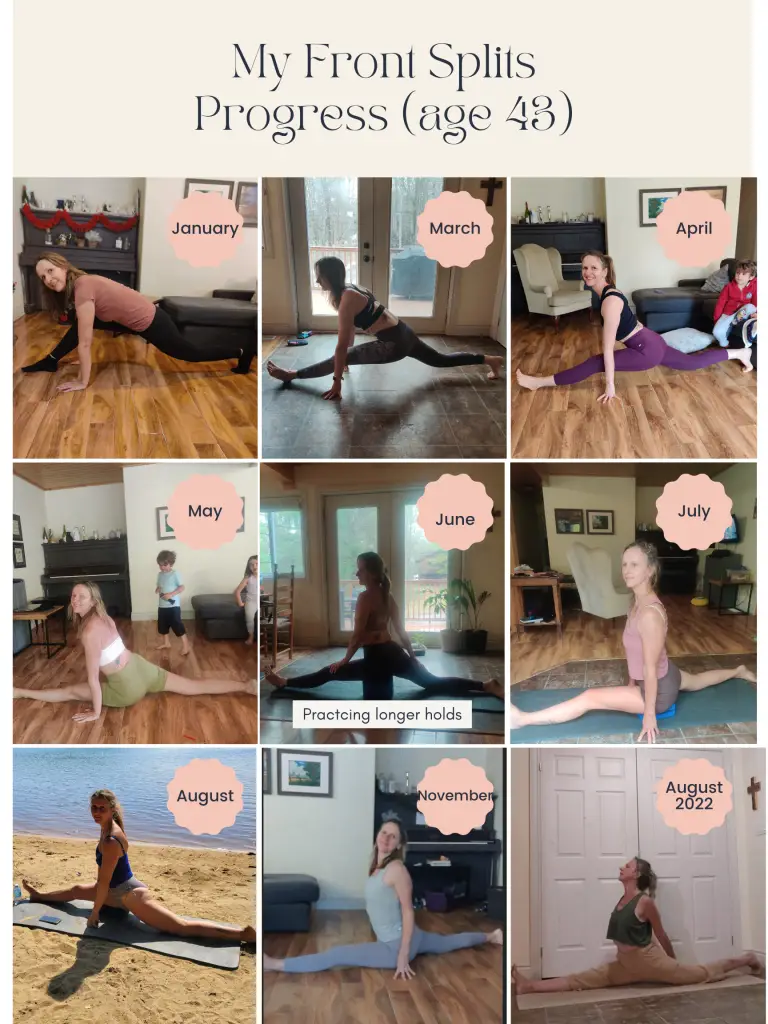
What Muscles Do Middle Splits Stretch?
In greater detail, the middle splits stretch the following muscles:
- Adductors: The adductors are a group of muscles inside the thigh, including the adductor longus, adductor brevis, and adductor magnus. These muscles are responsible for bringing the legs together and are stretched when the legs are spread apart in the middle splits.
- Hip flexors: The hip flexors are a group of muscles that attach to the hip and thigh bones and are responsible for lifting the legs up and down. The hip flexors are stretched in the middle splits as the legs extend to the sides.
- Hamstrings: While the middle splits primarily target the adductors and hip flexors, the hamstrings also play a secondary role in the movement. As the legs extend to the sides, the hamstrings are lengthened, which can help improve flexibility in this muscle group.
- Glutes: The gluteus maximus and medius are located in the buttocks and help to stabilize the hips during the middle splits. These muscles also play a secondary role in the movement and are stretched as the legs extend to the sides.
Why Are Middle Splits So Hard?
As you will see from my progress pictures, the middle splits have been more problematic for me to achieve. Why are the middle splits harder to get for some people?
The middle splits, also known as the straddle or side splits, can be challenging for many people due to several factors:
- Limited flexibility: The middle splits require a high degree of flexibility in the inner thighs, hips, and groin muscles, which can be challenging to achieve for some people.
- Lack of strength: The inner thighs, hips, and groin area muscles must be strong enough to hold the body in the split position. Without adequate strength, it can be difficult to maintain the position for any length of time.
- Structural limitations: Some people may have anatomical differences that make it harder to achieve the middle splits. For example, a person with a shallow hip socket may find it more challenging to open their legs wide (this video explains the structural aspect of the middle splits).
- Inadequate warm-up: Proper warm-up is essential before stretching exercises, including the middle splits. Without adequate preparation, the muscles may be tight, making achieving the full range of motion harder.
Achieving the middle splits requires consistent practice, patience, and persistence. It’s essential to work on flexibility and strength and listen to your body, progressing safely and comfortably.
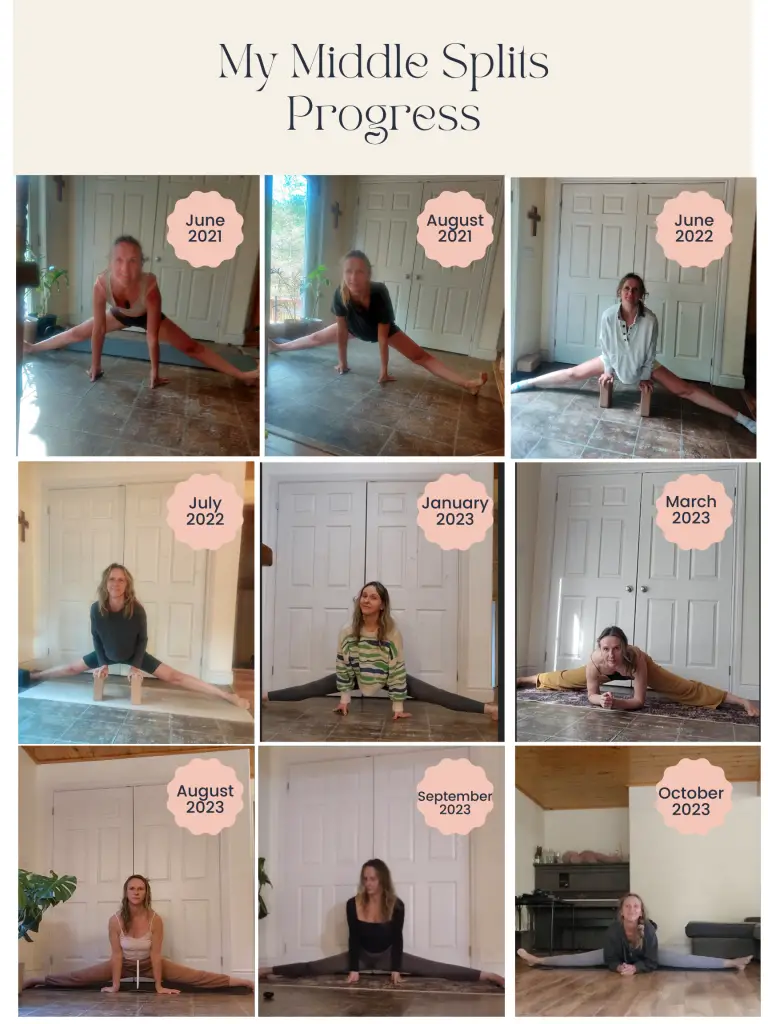
Are the Middle Splits Bad for You?
The middle splits can be safe and beneficial when practiced correctly and with proper preparation. However, like any physical activity, there is a risk of injury without good technique and caution.
Some potential risks of middle splits include:
- Strain or tear of the adductor muscles: The adductor muscles inside the thigh are most at risk of strain or tear during the middle splits. It’s important to gradually and safely increase flexibility and avoid pushing too hard or too quickly.
- Strain or tear of other muscles: The hamstrings, hip flexors, and glutes may also be at risk of strain or tear during the middle splits, especially if they are not properly warmed up or the body is forced into the split position.
- Joint pain or injury: The hip, knee, and joint joints risk pain or injury during the middle splits if proper alignment is not maintained or if the body is forced beyond its natural range of motion.
To reduce the risk of injury, it’s essential to properly warm up and stretch the muscles, use proper alignment and technique, progress gradually, and listen to your body’s limits. If you have any pre-existing injuries or medical conditions, it’s essential to consult with a healthcare professional before attempting the middle splits or any new exercise routine.

Stretches for Middle Splits
If you know my flexibility training approach, you know that I favor passive stretching for extraordinary flexibility gains. Once you can get in a pose, you can start using more active stretches and mobility exercises. to prepare your body. Today’s routine is no exception; it is still primarily passive. However, you can add some of my dynamic stretch options if they feel good.
Active Stretches for Middle Splits
Here are some middle splits exercises that I would consider to be active stretches (because they require the use of strength as well as flexibility):
- Side lunges or skandasana: In this pose, you step out to the side with one foot, bending the knee of the leg that stepped out while keeping the other leg straight. The hands can be brought together in a prayer in front of the chest or extended to the sides for balance. The pose is held for several breaths while feeling the stretch in the inner thighs and groin. The pose is then released by straightening the bent leg and returning the feet to hip-width apart.
- Goddess Pose: Stand with your feet wide apart and your toes turning outwards. Your knees are bent, so the thighs are parallel to the floor, tracking the knees over the feet. In this active stretch for middle split variation, you press one hand to the inside of that same thigh to stretch it further and switch from side to side (I do this in my Bird of Paradise flow).
- Half Middle Splits: My favorite active stretch for the middle splits (the only one I decided to include in today’s video routine). To get in your half splits, keep one leg bent (like in a frog pose) while the other is extended. Make the stretch active move from your forearm to supporting yourself with the strength of your legs.
- Active middle splits: You stretch in the middle splits as you activate your muscles. Imagine you are pulling your feet in and holding for 30 seconds. Release. Now, pull your feet out (they are not moving out, but you activate your muscles as if you were moving them out). Hold for 30 seconds. Lower deeper into your middle splits and repeat.
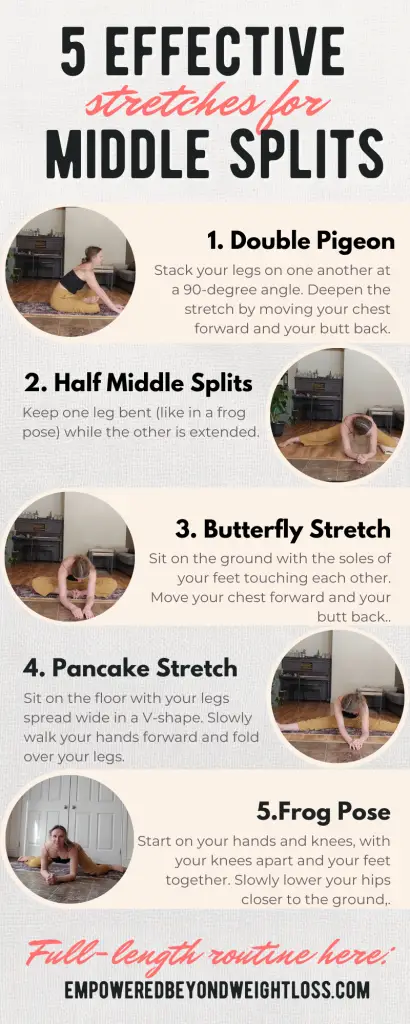
Passive Stretches for Middle Splits
Passive stretches for middle splits involve holding a stretch for an extended period with the help of gravity or props to increase flexibility. Here are a few passive stretches that can help with middle splits:
- Wide-Legged Seated Forward Fold (or pancake): Sit on the floor with your legs spread wide in a V-shape. Slowly walk your hands forward and fold over your legs, feeling a stretch in your inner thighs and groin. You can use a pillow or yoga block under your chest for support.
- Wall Splits: Lie on your back with your legs up against a wall, in a V-shape. Let gravity pull your legs apart, feeling a stretch in your inner thighs and groin. You can also use a yoga block or pillow under your hips for support.
- Frog Pose: Start on your hands and knees, with your knees apart and your feet together. Slowly lower your hips closer to the ground, feeling a stretch in your inner thighs and groin. You can use a pillow or yoga block under your chest for support.
- Butterfly Pose: Sit on the ground with the soles of your feet touching each other. Move your chest forward and your butt back, feeling a stretch in your inner thighs and groin. You can use pillows or yoga blocks under your knees for support.
- Pigeon Pose: Start in a downward-facing dog position. Bring your right knee forward and place it behind your right wrist. Slide your left leg back behind you, keeping your left hip on the ground. Slowly lower your body toward the ground, feeling a stretch in your right hip. You can use pillows or yoga blocks under your chest for support.
- Double Pigeon: Stack your legs on one another at a 90-degree angle. Deepen the stretch by moving your chest forward and your butt back.
Stretches for Middles Splits Video Routine

